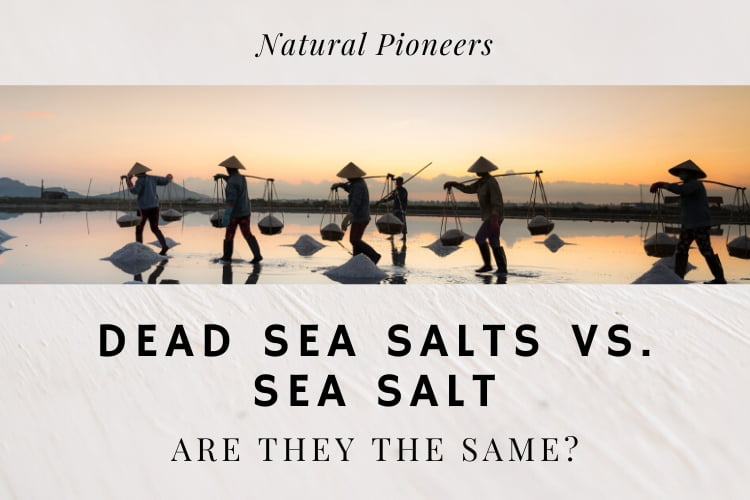
While Dead Sea salts and sea salt might sound similar, they are fundamentally different. This article explores Dead Sea salts’ and sea salt’s uses in food and baths.
In food, sea salt is a more natural, nutritious, and less refined alternative to table salt. Dead Sea salts are not safe for consumption. In baths, Dead Sea salts are superior to sea salt. Dead Sea salt baths & mud treat skin diseases like acne, psoriasis, dry skin, signs of aging, and arthritis.
Let’s take a look at sea salt first.
1. Sea Salt
Sea Salt In Food
Sea salt is a type of salt that comes from the evaporation of seawater. The taste, texture, and processing are what makes sea salt different from table salt. Sea salt is typically not or only minimally processed, according to the American Heart Association.
Unlike refined table salt, which usually contains added anticaking agents and iodine, sea salt is left in its natural state, still containing trace levels of minerals like magnesium, potassium, calcium and other nutrients. [1]; [2]
However, with 90% or more sodium chloride, the amount of minerals is small. Too small to have a measurable impact on our mineral intake. For example, with the recommended salt intake, we are consuming less than 1% of our daily required magnesium. [3]
Consequently, considering salt as a mineral supplier seems naive. The amount of minerals is so low that it’s practically impossible to meet daily requirements. [4]
While certainly not a significant mineral supplier, sea salt remains a more natural, less refined and more nutritious alternative to table salt. Sea salt doesn’t contain added ingredients like iodine and anticaking agents. Some chefs prefer it over table salt for its coarse, crunchy texture and stronger flavor. [5]; [6]
Studies show that the use of natural sea salt induces less hypertension compared to refined salt. [7]
When choosing a sea salt, we recommend looking for sources that are free of pollutants. According to a study, 90% of sea salts contain microplastics, with Asia as the hot spot of global plastic pollution. [8]; [9]
Sea salt from France for example, did not contain any microplastic particles in both replicate samples. We like to use Celtic sea salts harvested in the coastal areas of France. [10]
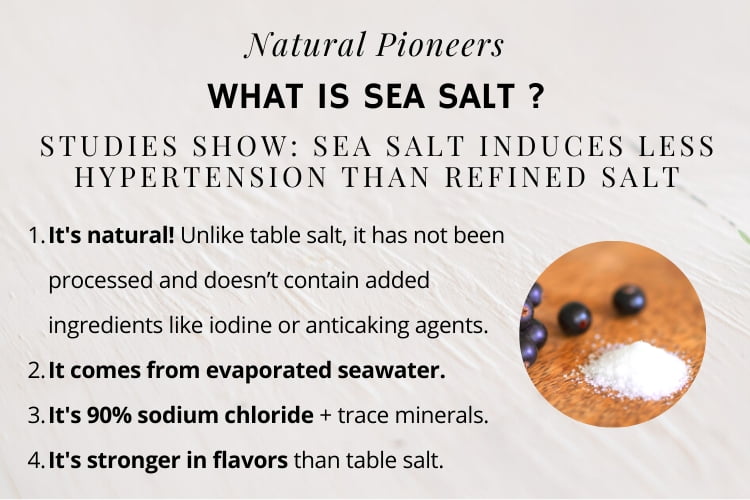
Sea Salt In Baths
Studies show a beneficial healing effect on skin when bathing in sea salt. However, studies found the effects of Dead Sea salts to be superior to common salt. We’ll get to Dead Sea salts next. [11]
Curious about Epsom salt? Read more: Dead Sea Salts Vs. Epsom Salt | The Difference
Will swimming in the ocean come with the same benefits as bathing in sea salt?
Many of us have heard the summer tale that ocean water will cure minor cuts and wounds. There is no evidence for that. In fact, the opposite might be true. Swimming in salty ocean water alters the skin microbiome and may increase the likelihood of infection, according to studies. [12]; [13]; [14]
In addition, most coastal areas receive untreated runoff from a series of storm drains throughout the year. Studies found higher risks for respiratory and gastrointestinal infections in researched coastal regions. [15]
Make sure that you take your salt bath at home, using clean water and a quality sea salt.
How To Do A Sea Salt Bath:
- Start running warm water into a clean bathtub. Be sure it’s not too hot as hot water can aggravate inflamed skin and draw moisture from your skin.
- Add 1 cup of sea salt under the running tap and mix with your hand until completely dissolved.
- Enjoy!
You want to make your own bath salt? Read more: How To Make Colloidal Oatmeal | Homemade Recipe & Benefits
Conclusion: Studies show that sea salt is a more natural, less refined, and more nutritious alternative to table salt. Sea salt doesn’t contain added ingredients like iodine and anticaking agents. Many prefer it over table salt for its coarse, crunchy texture and stronger flavor. Make sure to choose a sea salt without microplastic contamination (like Celtic sea salts). Using sea salts as a bath additive, studies show a beneficial healing effect on skin. Make sure to use clean water and a quality sea salt.
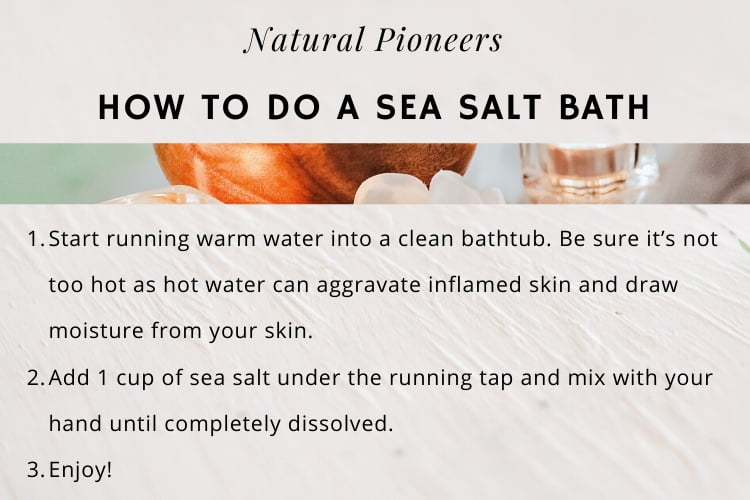
2. Dead Sea Salts
The Dead Sea is a salt lake and the biggest natural saline reserve in the world. When we hear the word salt, most of us associate it with table salt – the seasoning. In Dead Sea salts we’re talking about a complex mineral composition that is much more than just salt.
While the Dead Sea is much saltier than ocean water, the extracted salts are less salty than table salt. Table salt consists of about 98% sodium, while Dead Sea salts contain only about 8% sodium. 60% of Dead Sea salts are magnesium and potassium.
Dead Sea Salts are made up of about 60% magnesium and potassium, 8% sodium and some rare minerals.
Another misconception is that Dead Sea salts can be used as seasoning. While a small percentage of extracted Dead Sea salts are washed and processed to edible salt, the majority is not.
Regular Dead Sea salts are not safe for consumption and taste quite bitter.
Unlike sea salt, Dead Sea salts are mainly used for topical treatments. Only a very small percentage of Dead Sea minerals are processed to edible salt.
Curious about Himalayan salt? Dead Sea Salts Vs. Himalayan Salt | 7 Surprising Differences
In the medical field, topical treatments with Dead Sea salts and mud have shown to help with arthritis.
Their main use in cosmetic products, is to help with skin problems like stretch marks, acne, eczema, blemished skin, and aging signs. They can even cure eczema. And there are many studies that prove that Dead Sea salts and mud work for those conditions! [16]; [17]
With the shift towards more natural products, it’s no wonder that the global Dead Sea cosmetics market is booming and valued at a whooping USD 1.1 billion in 2018. [18]
Are Dead Sea minerals safe? Studies show that Dead Sea treatments have a good safety profile. The laboratory analysis of Dead Sea minerals reveals no mineral concentrations that could represent a health concern for their intended use. [19]
The main benefits of sea salt are seen were seen in studies that used 100% Dead Sea mud or Dead Sea salts. They were used as mud packages, masks and Dead Sea salt baths.
Curious about the best natural bath additives? Read more: What Is A Good Natural Bath Salt | Natural Bath Additives
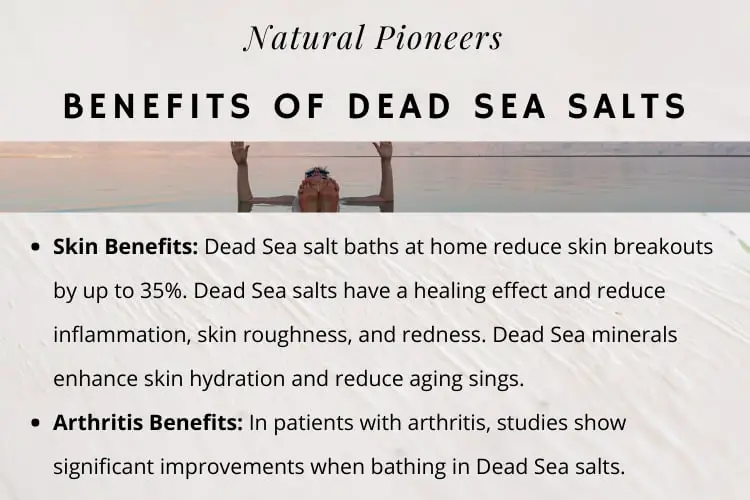
Dead Sea salts can help us in various ways:
- Dead Sea salt baths at home reduce skin breakouts by up to 35%. Dead Sea salts have a healing effect and reduce inflammation, skin roughness, and redness. [20]; [21]; [22]
- Dead Sea mineral baths restore moisture and enhance skin hydration. Dead Sea minerals contain a natural moisturizing factor that can improve the look of acne damaged skin. [23]
- Dead Sea baths reduce aging sings on human skin. Dead Sea minerals have a rejuvenating effect on your skin. [24]
- In rheumatoid arthritis patients, Dead Sea mud packs significantly improve morning stiffness, hand-grip strength and activities of daily living. [25]
- Dead Sea mud packs reduce pain severity in patients with chronic low back pain. [26]
- Dead Sea mud accelerates the wound healing process. [27]
- In patients with rheumatoid arthritis, daily baths in Dead Sea salts significantly improve morning stiffness, fifteen-meter walk time, hand-grip strength and circumference of joints. [28]
- Studies show Dead Sea spa therapy modalities help with psoriasis and psoriatic arthritis. [29]
- In patients with knee osteoarthritis, balneotherapy helps with pain, physical function and walking speed. [30]
Up for a trip to the Middle East?
- Baths in the Dead Sea help with Fibromyalgia. Studies show a relief of symptoms (pain, fatigue, stiffness, and anxiety) and reduced frequency of symptoms (headache, sleep problems, and subjective joint swelling). [31]
- Intermittent balneotherapy in the Dead Sea helps with knee osteoarthritis. Results lasted up to 6 months. [32]
Curious about the effects of Dead Sea mud for blemished skin? Read more: Is Dead Sea Mud Good For Acne?
Make sure you use 100% Dead Sea salts with no added ingredients to achieve the same effects as seen in studies.
How To Do A Dead Sea Salt Bath:
- Start running warm water into a clean bathtub. Be sure it’s not too hot as hot water can aggravate inflamed skin and draw moisture from your skin.
- Add 1/2 cup of Dead Sea salts under the running tap and mix with your hand until completely dissolved. Dead Sea salts will leave a mud film on the tub – it wipes off easily.
- Enjoy!
Conclusion: Dead Sea salts are not safe for consumption and are mainly used for medical purposes to treat diseases. Dead Sea salt baths and mud prove to be beneficial to help with skin diseases like acne, psoriasis, redness, dry skin, and signs of aging. Dead Sea salts also help when treating arthritis. Dead Sea salts are considered safe according to laboratory analyses.
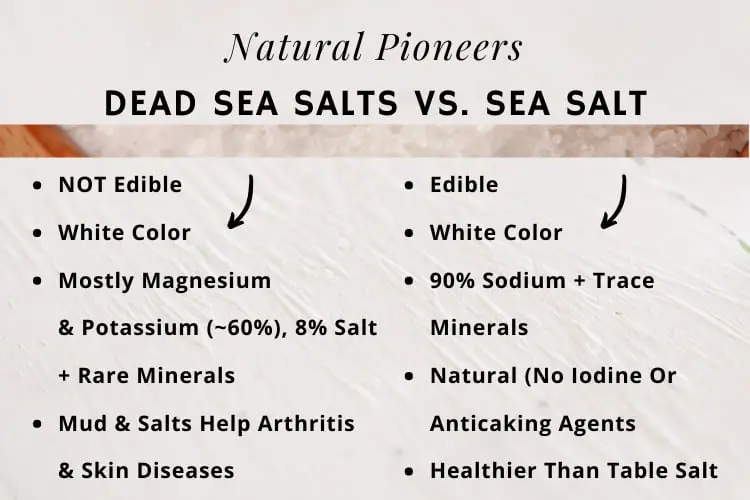
3. Conclusion
For use in food, sea salt is a more natural, less refined, and more nutritious alternative to table salt. Sea salt doesn’t contain added ingredients like iodine and anticaking agents. Many prefer it over table salt for its coarse, crunchy texture and stronger flavor.
Dead Sea salts are not safe for consumption and taste quite bitter.
When choosing a sea salt, make sure to choose a product without microplastic contamination. For example, Celtic sea salt harvested around the coast of France.
Studies show a beneficial healing effect on skin when bathing in sea salt. However, Dead Sea salts prove to provide superior health benefits.
Dead Sea salt baths and mud are mainly used for medical purposes and prove to be beneficial when treating skin diseases like acne, psoriasis, redness, dry skin, and signs of aging. Dead Sea salts also help when treating arthritis. Dead Sea salts are considered safe according to laboratory analyses.

